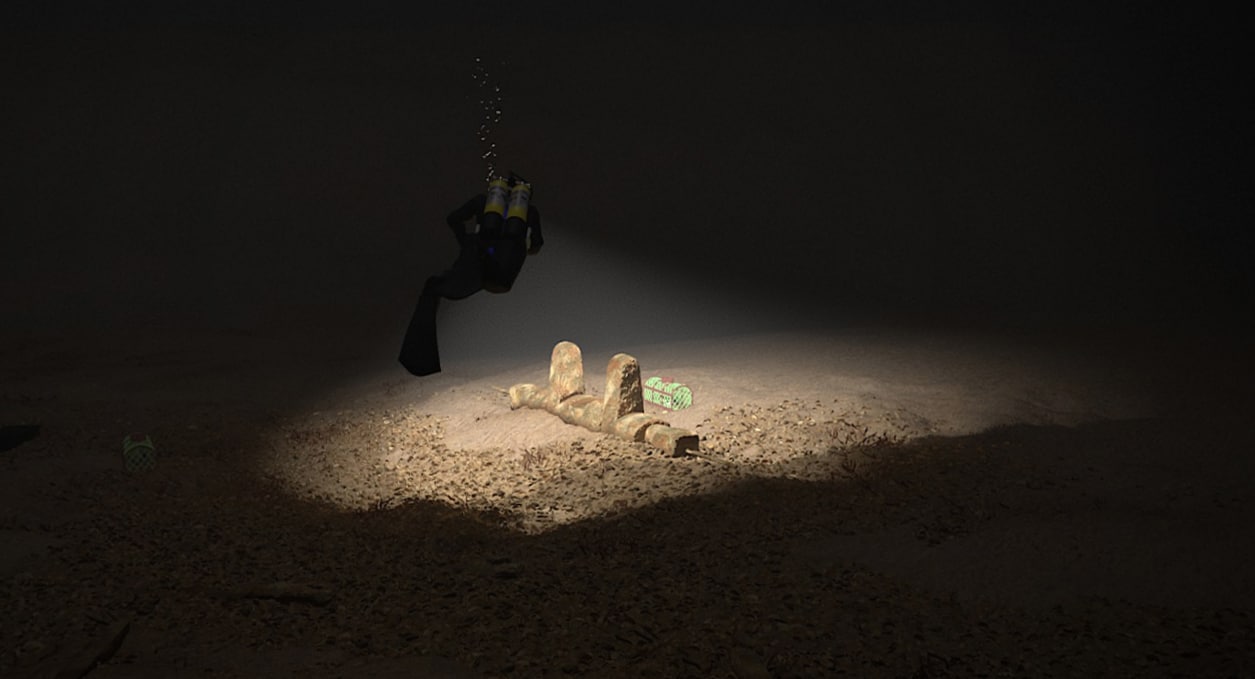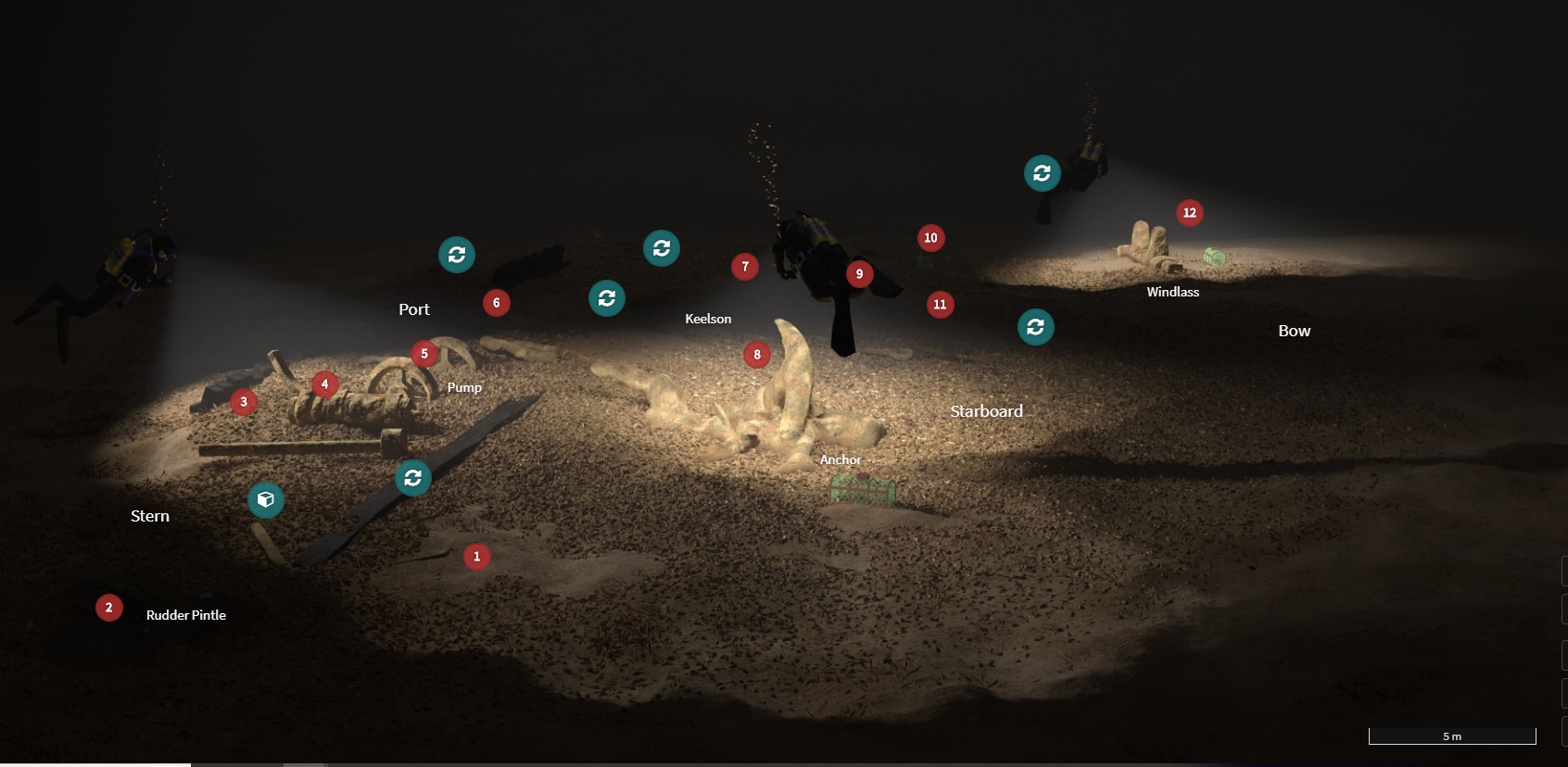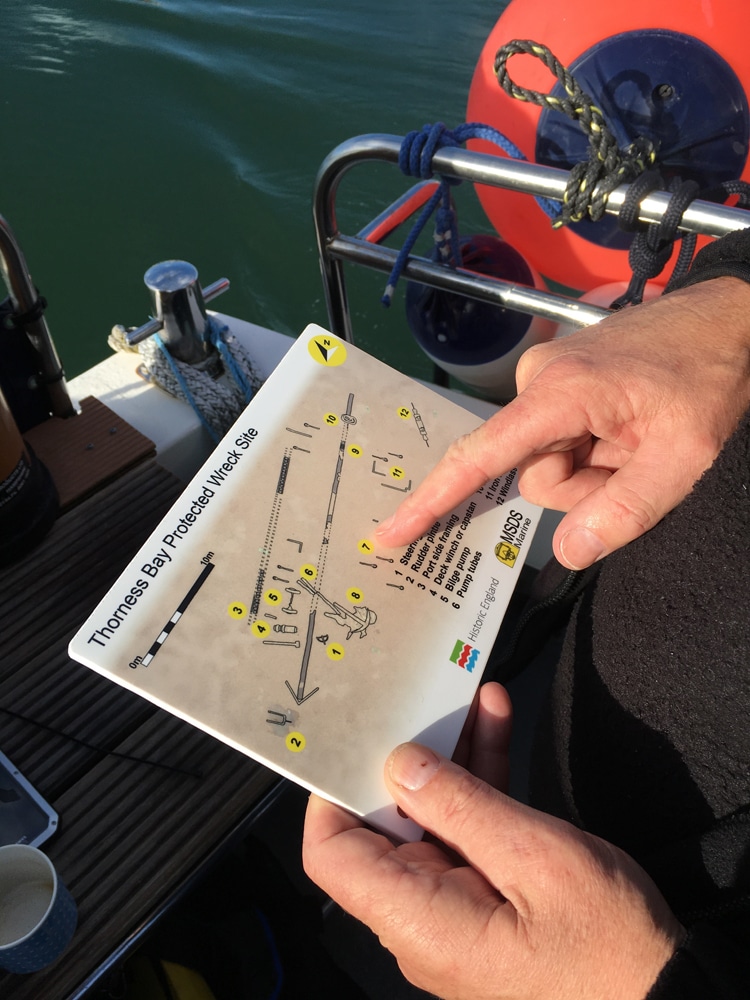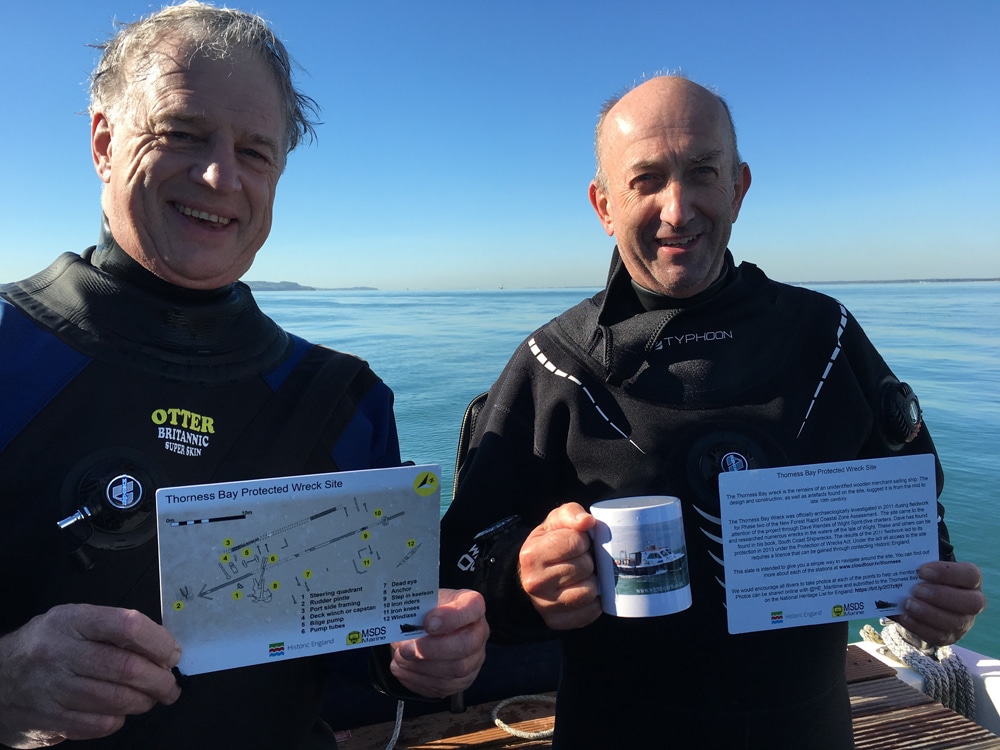News
New underwater trail for divers on protected wreck off Isle of Wight

This week another protected wreck site has been opened up for visiting divers with the creation of an underwater trail. Interpretation material provided by Pascoe Archaeology and MSDS Marine with funding from Historic England allows divers to explore the fascinating protected historic wreck site that lies in Thorness Bay off the coast of the Isle of Wight. The Thorness Bay wreck is the remains of a mid to late 19th century sailing ship lying in 21 metres of water.
The archaeological evidence previously gathered by divers indicates that the site is the remains of a wooden merchant sailing vessel. Judging from the extent of the visible remains, the vessel was c. 27m long and had a breadth of 7-8m. The presence of a large iron windlass, and other iron deck equipment indicates that the vessel was at least in use during the mid-late 19th century. At present the site has not been identified although one of the current licence holders for the site has found either a letter ‘G’ or a number ‘6’ in the vicinity of the bow which may be part of the name.
The Thorness Bay wreck was first brought to the attention of archaeologists in 2011 by skipper Dave Wendes of Wight Spirit Dive Charters as part of the New Forest Rapid Coastal Zone Assessment. The results of the 2011 fieldwork led to the site being protected under the Protection of Wrecks Act in 2013. Historic England identified it as a suitable site for increased diver visits due to interesting visible features. The site is largely robust and easy to navigate and its depth means it is well within the depths of recreational sports diving. The position of the wreck in the Solent means that vessels can mobilise to the site from a range of locations including the Isle of Wight, Lymington, Southampton and Portsmouth. Charter vessels are available within the area and there are a number of public and private slipways that can be used for launching the vessel.
Wight Dolphins BSAC club have worked with the archaeologists to develop the trail and to ensure it is something that the diving community will enjoy. The dive trail provides a simple interpretation slate to guide divers around the remains on the seabed. Visiting divers are encouraged to share photos and notes from their dives with Historic England to help them monitor the condition of the site.
Historic England recently also launched a virtual wreck discovery trail which includes 3D models of the wreck site and diver videos and photos, bringing to life the remains of the entire wreck. The virtual trail of the wreck allows non-divers to explore this fascinating site but also acts as a way for divers to plan their dive in advance of visiting the new trail.
Hefin Meara, marine archaeologist at Historic England, said: “We are delighted to have been able to open another protected wreck site up in this way with interpretation slates that really allow divers to get the most from their visit.”
Daniel Pascoe, Pascoe Archaeology Services, said, “One doesn’t often get the chance to dive a mystery shipwreck, especially in the Solent, but the Thorness Bay wreck is exactly that. In a deepish, and dark, part of the Solent exposed features of this unknown wreck appear ghostlike in the divers torch beams. I hope divers will enjoy visiting the site and perhaps even help us to finally put a name to this forgotten wreck through the information we gain through the scheme.”
Alison James, MSDS Marine, said, ‘Access for divers to protected wreck sites is something that is really important as they are a shared asset for everyone to enjoy, not just the archaeological community. Dive trails such as this are incredibly important”.
Thorness Bay is a Protected Wreck site and can only be visited with a licence, available from Historic England: https://historicengland.org.uk/listing/the-list/list-entry/1402103
Find out more about how to visit the dive trail at: http://msdsmarine.com/en/projects/thornessbay/
Visit the virtual wreck tour at: https://www.cloudtour.tv/Thorness
News
Book Review: Fire on Monroe Bravo by Fred Lockwood

Fire on Monroe Bravo is the latest book in the Jack Collier series by Fred Lockwood. Our story begins with our lead characters, Jack and Sandro, owners of Marine Salvage & Investigation Company, arriving on the Monroe Bravo Oil & Gas Platform in the North Sea. Having secured a contract for their vessel the MV Stavanger to act as support ship to the platform for TransGlobal Oil, our protagonists are on a celebratory visit.
However almost as soon as they arrive a series of explosions rock the platform, causing huge damage, loss of life and the very real danger of a massive human, ecological and financial disaster.

As the danger mounts for both our heroes and the surviving workers, Jack and Sandro will have to escape the inferno, all while trying to save the platform and the men still trapped unable to help themselves.
The disaster sets the scene for the unfolding story lines following the fate of the platform and our main characters, the police investigation into a suspected terrorist act and the actions of TransGlobal Oil as they attempt to navigate the pubic outcry and financial repercussions.
In his eighth book, Fire on Monroe Bravo, Fred Lockwood delivers an explosive thriller, with plenty of above and in-water drama, and our heroes fighting for survival, what more can you ask for?
We thoroughly recommend this read and look forward to the next in the series. For more information about his book series, you can check out the reviews of his previous books here on Scubaverse.
- Title: Fire On Monroe Bravo
- Author: Fred Lockwood
- ISBN: 979-8325324536
Available in a paperback version and for Kindle from Amazon and book stores.
Blogs
Alonissos: The complete diving destination (Part 1)

In June we were incredibly fortunate to be invited to dive in Alonissos, a small Greek Island in the Sporades island chain located in the North Aegean Sea. While I have long been a big fan of the Greek Islands as a great holiday destination, I had not had the opportunity to do any diving on previous visits and Mike and I were extremely excited to see what Alonissos had to offer both above and below the surface!

The Sporades are easily accessible via the airport in Skiathos (the first island in the chain), which is served by Jet2 flights from all major UK airports from May through October. Numerous ferries and charter boats make island hopping from Skiathos Town a breeze. After an hour boat ride, the picturesque port of Patitiri was a wonderful introduction to Alonissos, where we were met by our gracious hosts Kostas of Albedo Travel and Dias of Alonissos Triton Dive Center. Mike and I were delighted to be staying at the Paradise Hotel, aptly named for its stunning views over the sea and great location for walking to the waterfront.

Alonissos is beautifully situated in the National Marine Park of Alonissos and the Northern Sporades, the largest marine protected area in Europe. The surrounding seas offer fabulous marine life, including incredibly rare species such as the Mediterranean monk seal. They boast deep walls covered in gorgonians and sponges, stunning topography with caverns, swimthroughs and pinnacles, and the first accessible ancient shipwreck from 500BC!

In locations where historical sites have been reported, the waters are largely restricted, but with collaboration between government, underwater archeologists and dive centres, incredible underwater museums are being created for a truly unique diving experience. Alonissos is home to the first of these, the Ancient Shipwreck of Peristera Accessible Underwater Archeological Site. The chance to dive into history (along with reports of healthy reef life and amazing underwater topography) meant Mike and I were keen to get in the water.

Our introduction to the diving around Alonissos was at the Agios Georgios Pinnacles, in the channel between Alonissos and Skopelos. This fantastic site was named “The Chimney,’ and proved to have a huge amount to see. We got to a decent depth here (over 25m), and marvelled at a colourful reef wall with a wonderful swim through whose rocky walls were absolutely covered with life. As well as brilliant topography there was no shortage of macro life here. We saw numerous nudibranchs, five different species in total. The second dive at Mourtias reef nearby was a shallower dive along a nice wall with lots of crevices. Several moray eels and grouper called this site home. We enjoyed looking in the crevices for lobster and smaller benthic life, such as cup corals and tunicates.

Our itinerary allowed us two dives a day with afternoons left to explore the island with our hire car and evenings to enjoy the famous Greek hospitality. This proved to be a lovely mix of in-water and land based diversions.

The next days diving to the Gorgonian Gardens and Triton’s Cave was to be even better! These two stunning sites are nothing short of fabulous. The Gorgonian Gardens was a deep wall near to the Agios Georgios islands. The ever-present currents in this deep channel meant that the sea life was amazing … the namesake Gorgonian sea fans dotted the wall at a depth of 30 to 50 meters, getting ever larger the deeper we went. Above 30m was by no means less beautiful, with sponges, corals, scorpionfish, moray eels and some rare and colourful nudibranchs.

The second shallower dive of the day was to Triton’s Cave or the Cavern of Skopelos, on the east side of that island. The spectacular rock formations had wild striations both above and below the water making a truly epic topography. The cavern entrance was at 14m, and big enough for a buddy pair, winding up to 6m and passing two beautiful windows out into the blue. Emerging from the cavern, the light at the shallower depths and the incredible rock formations made for a fantastic gentle swimming safety stop and we all surfaced by the boat with massive grins.

Check out our next blog :Alonissos: The complete diving destination (Part 2)” to hear about our amazing dive on the 2500 year old Peristera Wreck!
Thanks to:
Alonissos Triton Dive Center https://bestdivingingreece.com/
Albedo Travel https://alonissosholidays.com/activities/
Paradise Hotel https://paradise-hotel.gr/
Alonissos Municipality https://alonissos.gr/en/
-

 Blogs2 months ago
Blogs2 months agoDiving With… Nico, Ocean Earth Travels, Indonesia
-

 News1 month ago
News1 month agoMurex Bangka Announce New Oceanfront Cottages & Beachfront Dining
-

 Blogs2 months ago
Blogs2 months agoA new idea in freediving from RAID
-

 Marine Life & Conservation1 month ago
Marine Life & Conservation1 month agoIceland issue millionaire whale hunter a licence to murder 128 vulnerable fin whales
-

 Marine Life & Conservation2 months ago
Marine Life & Conservation2 months agoThe Shark Trust Great Shark Snapshot is back
-

 News3 months ago
News3 months agoCharting New Waters; NovoScuba Goes Global with the Launch of their Revolutionary Dive Training Agency!
-

 Gear News1 month ago
Gear News1 month agoNew Suunto Ocean – a dive computer and GPS sports watch in one for adventures below and above the surface
-

 Marine Life & Conservation Blogs2 months ago
Marine Life & Conservation Blogs2 months agoBook Review: Plankton


















